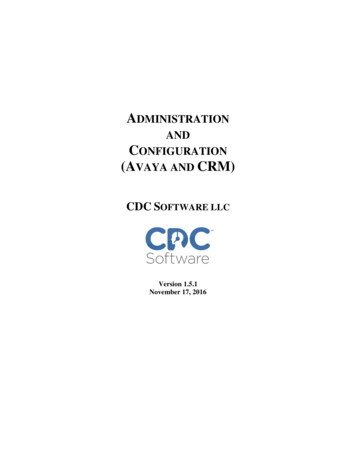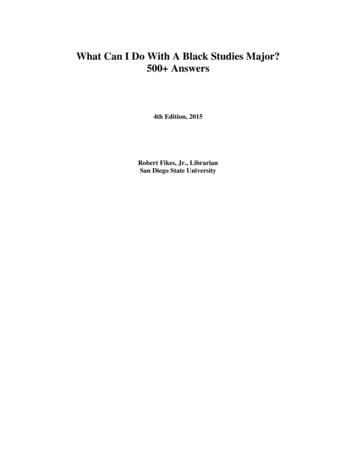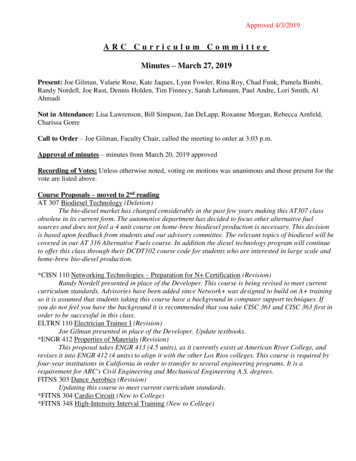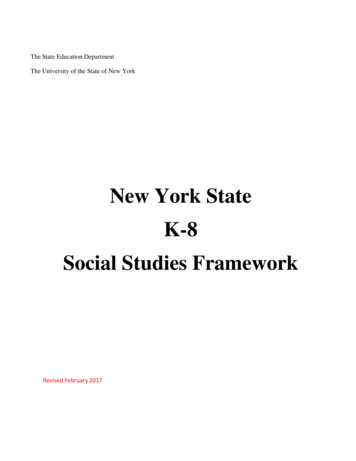
Transcription
are going to be passionate too. And that meanswe’re going to have a passionate future –a passionate generation!Grade 12 Teacher’s GuideIf I’m passionate about the subject, my learnersThe accompanying Learner’s Book is written in accessible language and contains all the content your learners need to master.The exciting design and layout will keep their interest and make teaching a pleasure for you.We would love to hear your feedback. Why not tell us how it’s going by emailing us at businessstudies@viaafrika.com?Alternatively, visit our teacher forum at www.viaafrika.com.Language: Englishwww.viaafrika.comVia Afrika Business Studies1. The series was written to be aligned with CAPS. See page 16 to see how CAPS requirements are met.2. A possible Annual Teaching Plan has been included. See page 5 to see how much time this could save you.3. Each topic starts with an overview of what is taught, and the resources you need. See page 18 to find out how this willhelp with your planning.4. There is advice on pace-setting to assist you in completing all the work for the year on time. Page 18 shows you how thisis done.5. Advice on how to introduce concepts and scaffold learning is given for every topic. See page 19 for an example.6. All the answers have been given to save you time doing the exercises yourself. See page 20 for an example.7. Also included is a CD filled with resources to assist you in your teaching and assessment. See the inside front cover.Grade 12 Study GuideC. Chaplin, E. Llewellyn, P. bEan, M. Kleyn, A. Marx T.D.Kotze, T.R. Maliehe— Llewellyn Scholtz, TeacherVia Afrika understands, values and supports your role as a teacher. You have the most important job in education, and werealise that your responsibilities involve far more than just teaching. We have done our utmost to save you time and makeyour life easier, and we are very proud to be able to help you teach this subject successfully. Here are just some of the thingswe have done to assist you in this brand-new course:Via AfrikaBusiness Studies
Business StudiesGrade 12ISBN: 978-1-41546-302-4
Term 1 Topic 1 Macro environment: impactof recent legislation on businessOverviewThis chapter covers the effects of the following legislation on South African businesses: Skills Development Act No. 97 of 1998Labour Relations Act No. 66 of 1995Employment Equity Act No. 55 of 1998Basic Conditions of Employment Act No.75 of1997Broad Based Black Economic Empowerment ActNo. 53 of 2003National Credit Act No.34 of 2005Consumer Protection Act No.68 of 20081 IntroductionRecap what you learnt in grades 10 and 11 about the different macro environmental factorsthat affect a business. The macro environment includes external and uncontrollable factorsthat influence a business decision making, and affect its performance. These factors includeeconomic factors; demographics; legal, political, and social conditions; technologicalchanges; and natural forces.Laws are an important part of the business world. The legal system is very complicated andpeople who run businesses need to have a good understanding of it.During the apartheid era, apartheid legislation determined where people were allowed to live andwork. Foreign countries who had invested in South Africa disinvested in protest against apartheidpolicies and legislation. Via Afrika Publishers
Disinvestment is when businesses or countries remove all of their investments from a country tocreate an economic incentive for that country to change its policies. Disinvestment in South Africaresulted in capital flight. Capital flight happens when money flows out of a country’s economy veryquickly as a response to a political event.After 1994, many of South Africa’s laws, especially in the field of labour and the consumer,were revised to create fair employment and trade conditions for all South Africans.The responsibility for compliance with any of the Acts rests with management alone. Failureto comply with the law can have serious consequences such as: Criminal or financial penaltiesMake members of a close corporation or directors of a company personally liable forthe businesses actionsGive the business a bad reputation.2 The Skills Development Act 97 of 1998 and the Skills Development LeviesAct of 19992.1Nature and purposeThe Skills Development Act and the Skills Development Levies Act were passed in 1998 and1999 respectively.The reason behind this was that South Africa was not equipped with the skills it needed foreconomic growth, social development and sustainable employment growth.The National Skills Authority was established in terms of the Skills Development Act of 1998and was made up of representatives from business, labour, government and other bodiesthat reflected community and South African society.The National Skills Development Strategy aims to: Develop the skills and learning capacity of employees Make it possible for employers to become more productive and competitive Reverse apartheid imbalances Create a more inclusive and cohesive society. Via Afrika Publishers
Basic Guide to Skills Development LeviesEmployers must pay 1% of their workers’ pay to the skills development levy. The moneygoes to Sector Education and Training Authorities (SETAs) and the Skills Development Fundto pay for training.The Skills Development Levies Act applies to all employers except:The public serviceReligious or charity organisationsPublic entities that get more than 80% of their money from Parliament; andEmployers –o Whose total pay to all its workers is less than R 250 000 per year; ando Who do not have to register according to the Income Tax Act. SETAs: 2.2Develop sector skills plans in line with the National Skills Development StrategyApprove the workplace skills plans submitted by businesses in their sectorsPromote and establish learnerships.Pay grants to participating businesses, provided that those businesses havesubmitted workplace skills plans and implementation reports to their SETA.Implications for small and large businesses All business can benefit from the skills development initiativesA motivated and well-trained work force adds value to the businessHR managers, line managers and staff managers must know the requirements andimplications of the legislationThe 1% Skills Development Levy must be paid within seven days after the end of the monthTo create a learnership a formal learnership agreement has to be entered into by both partiesThe employer has the following responsibilities: to employ the learner for the period specified inthe agreement, to provide the learner with practical experience, and to give the learner time toattend the education and training specified in the agreementEmployers can be fined or even imprisoned (for a period not exceeding one year) if they commitan offence under the Skills Levy ActThe Income Tax Act (also applicable to SLA), requires all employers to keep a record of all theremuneration paid to every employee, as well as the Employees’ Tax deducted from theemployees’ remuneration and levies paid. Via Afrika Publishers
2.3 National Skills Development Strategy and the Human Resources Development StrategyThe aim of the National Skills Development Strategy is: To improve the skills development system so as to be more responsive to labour marketneeds and social equity requirements. To integrate workplace training and theoretical learning To improve the skills level of graduates of secondary and tertiary education To address skills shortages in artisanal, technical and professional fields To reduce the over-emphasis on NQF level 1-3 learnerships To equip those in the workforce with sufficient technological skills To improve co-operation between universities, further education and training colleges andsector education and training authorities (SETA) To support economic growth and development through viable skills development To develop sufficient skills for rural development.Co-operation and co-ordination from key stakeholders, such as government, the SETAs andemployers, is essential for the realisation of the NSDS III goals. The Department of HigherEducation and Training (DHET), the SETAs and the National Skills Fund are the key drivers ofNSDS III. DHET.3 Labour Relations Act (LRA) 66 of 19953.1Nature and purposeThe Labour Relations Act (LRA), Act 66 of 1995 aims to promote economic development,social justice, labour peace and democracy in the workplace.The Labour Relations Act applies to all employers, workers, trade unions and employers’organisations, but does not apply to members of the: National Defence ForceNational Intelligence AgencySouth African Secret Service.Trade unions are recognized under the 1996 Constitution of South Africa, which provides forthe right to join trade unions, and for unions to collectively bargain and strike. Via Afrika Publishers
Three institutions have been created to reduce industrial relations conflict, and eliminateunfair discrimination and redress past discrimination in the workplace: the NationalEconomic Development and Labour Council (NEDLAC), the Labour Court, and the Council forConciliation, Mediation and Arbitration (CCMA).For most businesses the fact that the LRA prescribes rules on how to dismiss employeesmakes it a very important. However, the purpose of the act covers more than that – itpromotes economic development, social justice, labour peace and the democratisation ofthe workplace through:3.1.1Freedom of associationFreedom of association means the right to come together with other individuals andcollectively express, promote, pursue and defend common interests. This includes the rightto join a union.3.1.2Organisational rightsThe Act allows trade unions to gain access to the business’ premises to recruit members andhold meetings.3.1.3Bargaining and statutory councilsBargaining councils are formed by registered trade unions and employers’ organisations.They deal with collective agreements, attempt to solve labour disputes, and make proposalson labour policies and laws. As well, they may administer pension funds, sick pay,unemployment and training schemes, and other such benefits for their members.3.1.4Commission for Conciliation, Mediation and ArbitrationThe Commission for Conciliation, Mediation and Arbitration (CCMA) is a dispute resolutionbody established in terms of the Labour Relations Act, 66 of 1995 (LRA). It is an independentbody, does not belong to and is not controlled by any political party, trade union orbusiness.The LRA makes provision for disputes that cannot be solved in the workplace.If this process fails the dispute is referred to the Labour Court.3.1.5 The Labour Court and the Labour Appeal CourtThe Labour Court has the same status as a high court. The Labour Court adjudicatesmatters relating to labour disputes. Appeals are made to the Labour Appeal Court. Via Afrika Publishers
3.1.6 Strikes and lock-outsIf a strike does not comply with the provisions of the LRA, the Labour Court can grant anorder to restrain any person from participating in such action. The Labour Court may alsoorder payment to the employer for losses sustained as a result of the illegal strike or lockout.3.1.7 Workplace forumsThe main aim of workplace forums is to solve labour-related problems by establishing cooperative relationships between all workers (also non-trade union workers) and theemployer. A workplace forum may be established in a business with more than 100employees. Only registered trade unions may apply to the CCMA for the establishment of aworkplace forum.3.1.8 Unfair dismissalDismissal is unfair if: 3.2A worker intended to or did take part in or supported a strike or protestA worker refused to do the work of a striking or locked out co-worker, unless hisrefusal will endanger life or healthA worker is forced to accept a demandA worker intended to or did take action against an employer by –o Exercising a right; oro Taking part in proceedings; orA worker is pregnant or intends to be pregnantAn employer discriminated against a worker because of race, gender, sex, ethnic orsocial origin, colour, sexual orientation, age, disability, religion, conscience, belief,political opinion, culture, language, marital status or family responsibilityAn employer cannot prove o A worker’s misconduct or inabilityo That the employer’s operational needs are valido That the dismissal procedure was fair.Implications for businessesThe LRA follows the principle of collective bargaining and puts structures in place with whichdisputes in the workplace can be settled. This has advantages for both employers andemployees and promotes a healthy relationship between them. Non-compliance with LRArules and regulations also poses a very real risk to employers because there is an effectiveand inexpensive (free) option to employees in the form of the CCMA and theDepartment of Labour. Via Afrika Publishers
CCMA fees and costsWhen asked by employees, employers, or other interested parties for advice or training teCCMA will assist. In 2012 the fee was between R1 650,00 and R1 835,00 for each day or partof a day.4 Basic Conditions of Employment Act 75 of 19974.1Nature and purposeThe 1996 South African Constitution (section 23) gives every worker and employer the right to fairlabour practices. The Act applies to all workers and employers except members of the NationalDefence Force, National Intelligence Agency, South African Secret Service and unpaid volunteersworking for charities.4.1.1Working timeA worker must NOT work more than: 45 hours in any weekNine hours a day if a worker works five days or less a weekEight hours a day if a worker works more than five days a week.OvertimeIf overtime is needed, workers must agree to do it and they may not work for more thanthree hours overtime a day or ten hours overtime a week.Overtime must be paid at 1.5 times the workers' normal pay or, by agreement, get paid timeoff.4.1.2 Leave Annual leaveA worker can take up to 21 continuous days' annual leave or by agreement, one day forevery 17 days worked or one hour for every 17 hours worked.Leave must be taken not later than six months after the end of the leave cycle.An employer can only pay a worker instead of giving leave if that worker leaves the job. Via Afrika Publishers
Sick leaveA worker can take up to six weeks paid sick leave during a 36-month cycle.During the first six months, a worker can take one day's paid sick leave for every 26 daysworked.An employer may want a medical certificate before paying a worker who is sick for morethan two days at a time or more than twice in eight weeks. Maternity leaveA pregnant worker can take up to four continuous months of maternity leave. She can startleave any time from four weeks before the expected date of birth OR on a date a doctor ormidwife says is necessary for her health or that of her unborn child. She also may not workfor six weeks after the birth of her child unless declared fit to do so by a doctor or midwife.A pregnant or breastfeeding worker is not allowed to perform work that is dangerous to heror her child. Family responsibility leaveFull-time workers employed longer than four months can take three days' paid familyresponsibility leave per year on request when the worker's child is born or sick or for thedeath of the worker's spouse or life partner, parent, adoptive parent, grandparent, child,adopted child, grandchild or sibling.An employer may want proof that this leave was needed.4.1.3 Remuneration, deductions and notice of terminationThe employee must be paid according to the agreement with the employer and deductionsmust be agreed to by the worker in writing or if the employer is required to do so by law(e.g. Income tax and UIF).Notices must be given in writing.The employer may pay for the notice period instead of giving notice.The worker still has the right to challenge the fairness of the dismissal.The worker must be paid for any accrued annual leave.If the termination of employment is because of a change in business operations(retrenchment) then severance pay (one week for every full year worked) has to be paid tothe worker. Via Afrika Publishers
4.2.4 Administrative obligationsAmongst other things employers must keep a record of at least: The worker's name and jobTime workedMoney paidDate of birth for workers under 18 years old.4.3Implications for businessesEmployers should have a good understanding of their obligations. It has become essentialfor all companies to have access to a specialist who is familiar with this legislation and itsprinciples. Failure to comply with this Act can lead to fines or criminal prosecution.5 Compensation for Occupational Injuries and Diseases (COIDA) Act 61fo19975.1Nature and purposeThe purpose of the Act is to provide compensation for disablement caused by occupational injuriesor diseases sustained or contracted by employees in the course of their employment, or for deathresulting from such injuries or diseases, and to provide for matters connected therewith.Businesses have the following responsibilities in terms of the Occupational Health and Safety Act of1993: The working environment must be made safe for workers and there must be no risks to theirsafetyWorkers must receive information, instructions, training and supervision to ensure thehealth and safety of all employees. Via Afrika Publishers
5.2Implications for businesses All businesses must register their business with the commissioner of theCompensation FundEach year the business must provide the commissioner with information on theworkers employed, the wages paid to them and the time they have workedThese records must also be kept safely by the business for a period of four years.6 The Employment Equity Act (EEA) of 19986.1 Nature and purposeThe overall aim of the Employment Equity Act (EEA) is to achieve equity in the workplacethrough: The prevention of discrimination, which applies to all employers The implementation of affirmative-action measures.The Act states that no person may unfairly discriminate (directly or indirectly) against anemployee on one or more of the following grounds: race, gender, sex, pregnancy, maritalstatus, ethnic or social origin, colour, sexual orientation, disability, HIV status, culture orbirth.6.2 Implications for the employer Employers must prepare employment equity plans in accordance with the Act These plans must be submitted to the Department of Labour for assessment Failure to comply with the Act may result in fines ranging from R1/2 million to R1million.7 Black Economic Empowerment Act of 2003 and the Broad-based BlackEconomic Empowerment (BBBEE) Act7.1 Nature and purposeThe Act seeks to correct the disparities caused by Apartheid by promoting newopportunities for, and increasing the levels of participation of, previously disadvantagedindividuals and companies in the ownership, management and control of the South Africaneconomy. Via Afrika Publishers
7.2 Implications for businessesBBBEE compliance is measured in the seven key BBBEE areas of the business. These are: Ownership: points are earned by selling shares to black peopleManagement Control: points are earned by appointing black top managers anddirectorsEmployment Equity: points are earned by employing junior/middle/seniormanagers and for smaller businesses black workersSkills Development: points are earned by training employees through on the jobtraining or formal trainingPreferential Procurement: points are earned by purchasing goods and services fromother businesses with a good BEE ScorecardEnterprise Development: points are earned by assisting smaller black ownedbusinesses to growSocio economic Development: points are earned by supporting black social causes.8 National Credit Act of 20058.1 Nature and purposeThe National Credit Act has put into place protection measures that aim to improveconsumer rights as well as protect and streamline credit transactions.8.2 Implications for businessCredit providers must do an affordability assessment to ensure that the consumer has theability to meet their obligations in a timely manner.Some of the requirements of the Act are: All credit contracts must be in a language and form which are easily understandableand should be in at least two languagesAll credit providers are obliged to do an analysis of the consumer’s profile, to ensurethat the provider can afford the credit applied forOne of the main purposes of the Act is to prevent discrimination in the credit marketand to ensure that credit is available to all South African citizensThe Act gives a consumer, whose application for credit was refused, the right towritten reasons for the decisionA cooling off period is compulsory for all credit agreementsConsumers under credit agreements have the right to return the purchased goods,at any given time during the contract, to the provider to be resold. Via Afrika Publishers
9 Consumer Protection Act of 20099.1 Nature and purposeThis Act has been brought into law to promote and advance the social and economicwelfare of all consumers.9.2 Impact of the Act on different aspects of businessExamples of the impact the Act may have on different aspects of doing business are: The Act prohibits discriminatory marketing The Act gives the consumer the right to select suppliers; to be given estimates; theright to choose or examine goods; the right to return goods and so-called unwantedgoods. Consumers are entitled to information in plain and understandable languageThe Act prohibits unacceptable conduct; false or misleading representations. QuestionsQuestion 1: Multiple choiceChoose the correct answer. Only write the letter of the answer you select.1.1The Skills Development Act and the Skills Development Levies Act were passed in andrespectively:A1985, 1986B1998,1999C2000, 2010D1976, 1978(2)Question 2: Multiple choiceChoose the correct answer. Only write the letter of the answer you select.2.1The Labour Relations Act applies to all employers, workers, trade unions andemployers’ organisations, but does not apply to:ANational Defence ForceAccountantsBCLawyersDTeachers(2) Via Afrika Publishers
Question 3: Multiple choiceChoose the correct answer. Only write the letter of the answer you select.3.1The Labour Court has the same status as a :AMagistrates CourtBSupreme CourtCHigh CourtDConstitutional Court(2)Question 4: Multiple choiceChoose the correct answer. Only write the letter of the answer you select.4.1A worker must NOT work more than:A45 hours in any weekBCD10 hours in any week35 hours in any week60 hours in any week(2)Question 5: Multiple choiceChoose the correct answer. Only write the letter of the answer you select.5.1The Consumer Protection Act of 2009 was bought into existence to:Apromote and advance the prosperity of manufacturersBpromote economic sustainabilityCpromote and advance the economic welfare of the wealthyDpromote and advance the social and economic welfare of all consumers. (2)Question 6: Multiple choiceChoose the correct answer. Only write the letter of the answer you select.6.1The Black Economic Empowerment Act was passed in :A1994B2002C2003D1995 (2)Question 7: Why is contemporary legislation a challenge to businesses? (2)Question 8: Why do consumer rights have implications for businesses? (4)Question 9: According to the COIDA, what are the obligations of employers? (12)Question 10: What is industrial action, and what are the two kinds of industrialaction? (6) Via Afrika Publishers
Term 1 Topic 2 Human resources functionOverviewThe human resources function is a very important part of any business because it deals with peopleand with complying with laws. People working in the HR department must be able to answerquestions such as: What is the best way to go about hiring new employees?What is the correct way to pay salaries and wages?What laws must be complied with?Recruitment procedures job specificationjob descriptionselection & screeninginductionSalary determination piecemeal and time-related),including personal tax; link tobasic conditions of employmentemployee benefits: pension,medical, otherLegislation affecting human resources: Labour Relations Act (LRA) No.66 of1995, Basic Conditions of Employment Act(BCEA) No.75 of 1997, Employment Equity Act (EEA) ) No.55of 1998, Compensation for OccupationalInjuries and Diseases Act (COIDA)No.61 of 1997Human resources training Skills Development Act (SDA) No.97 of1998 and the link with SETAs,learnerships, skills programmes,qualifications, National Qualifications Via Afrika Publishers
1 Analysis of human resources activitiesRecruitment is the process by which a business seeks to hire the right person for a vacancy.Recruitment is an ongoing process and possible reasons for recruitment within a business include: Expansion of the businessExisting employees leaveBusiness needs employees with new/advanced skillsThe business may be relocatingEmployees retireEmployees may be dismissed.Internal recruitment involves appointing existing staff from within the organisation.External recruitment involves hiring staff from outside the organisation.Once the most suitable candidate has been selected, s/he must be offered the position and acontract of employment must be signed by both the employer and the employee.Induction is the process of introducing new employees to the business, fellow employees, thespecific job and the corporate culture of the organisation.Good induction practices include: Having clear performance standards Allowing for "settling-in time" Providing support and a mentor to assist the new employee Ensuring the new employee feels part of the team Giving initial tasks that provide success.A salary is regular payment for employment which has been agreed upon and signed byemployer and employee. Usually a salary is paid on monthly not on hourly, daily, weekly orpiece-work basis.Other benefits such as pensions, retirement annuity and car allowance may also be part of anemployment contract with an employee and must be dealt with by the HR department. Via Afrika Publishers
2 HR proceduresRecruitmentThe business writes a job description and job specification for the vacancy and then either selectssomeone internally or sources externally. This can be done by: Placing advertisements in newspapers or notice boards Recruiting at special events e.g. during a university’s open day Vacation work, e.g. when an enterprise decides to recruit a student who has workedpermanently at the enterprise during the holidays Using a computer database, e.g. by storing all the information of candidates who havepreviously applied for jobs Making use of recruitment agencies.Internal recruitment involves appointing existing staff from within the organisationExternal recruitment involves hiring staff from outside the organisationJob descriptionA job description refers to the content of the job itself and sets out the duties and responsibilitiesrequired of the person employed to do the job and needs to outline: The title of the job The location of the job The duties of the job.Job specificationA job specification indicates the specific qualifications, skills and experience required of the personwho will fill the job. It will need to set out: Qualifications required Personal qualities needed Work experience required.SelectionSelection means identifying and hiring the most appropriate candidate to fill a post. HR oftenreceives many applications when a job is advertised. Via Afrika Publishers
The process of selecting involves: Advertising, either internally or externally Short-listing suitable candidates Checking on CV's and references Interviewing the shortlisted candidates Selecting the correct candidate for the job.InterviewingThe purpose of the interview is to meet the applicant personally and to make sure he or she will fitinto the company and is capable of fulfilling the advertised position.3 Human resources legalitiesLabour Relations Act (LRA) No. 66 of 1995This Act sets out the laws that govern labour in South Africa. It is guided by Section 27 of theConstitution, which entrenches the rights of workers and employers to form organisations forcollective bargaining. Together with the Basic Conditions of Employment Act, it also ensures socialjustice by establishing the rights and duties of employers and employees. It also regulates theorganisational rights of trade unions deals with strikes and lockouts, workplace forums and otherways of resolving disputes. It provides a framework for the resolution of labour disputes through theCommission for Conciliation, Mediation and Arbitration (CCMA), Labour Court and Labour AppealCourt.Basic Conditions of Employment Act (BCEA) No. 75 of 1997The BCEA is designed to protect employees against unfair labour practices and exploitation. It statesthe minimum conditions of employment that must be adhered to by both employers and employees.It is up to the employer to offer better conditions of employment than stated in the BCEA.Employment Equity Act (EEA) no.55 of 1998The purpose of the Act is to achieve equity in the workplace by: Promoting equal opportunity and fair treatment in employment through theelimination of unfair discriminationImplementing affirmative action measures to redress the disadvantages inemployment experienced by designated groups, to ensure their equitablerepresentation in all occupational categories and levels in the workforce. Via Afrika Publishers
Occupational Injuries and Disease Act (COIDA) No. 61 of 1997The objective of Compensation for Occupational Injuries and Diseases Act no 61 of 1997 (COIDA) isto pay compensation out to an employee or his dependents, where, as a result of his activities in thework situation, he died or was partially or totally disabled or contracted an occupational disease.COIDA thus acts as insurance in order to safeguarded the
The exciting design and layout will keep their interest and make teaching a pleasure for you. We would love to hear your feedback. Why not tell us how it’s going by emailing us at businessstudies@viaafrika.com? Alternatively, visit our teacher forum at www.viaa










